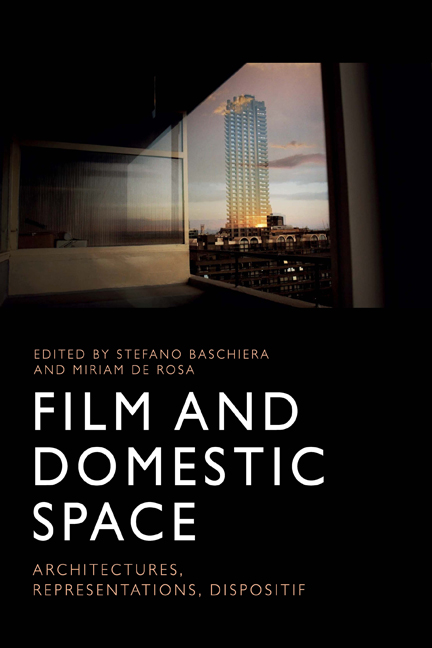Book contents
- Frontmatter
- Contents
- List of Figures
- Notes on the Contributors
- Acknowledgements
- Introduction
- 1 Architectures of Ubiquity: The Colonial Revival in Film and Television
- 2 No Down Payment: Whiteness, Japanese American Masculinity and Architectural Space in the Cinematic Suburbs
- 3 Resist, Redefine, Appropriate: Negotiating the Domestic Space in Contemporary Female Biopics
- 4 Liminal Spaces, Lesbian Desire and Veering off Course in Todd Haynes’s Carol
- 5 A Home on the Road in Claire Denis’s Vendredi soir
- 6 Acoustic Ectoplasm and the Loss of Home
- 7 Our House Now: Flat and Reversible Home Spaces in Post-war Film and Television
- 8 From Myth to Reality: Images of Domestic Space in Post-Soviet Baltic Films
- 9 No | Home | Movie: Essay Film, Architecture as Framing and the Non-house
- 10 At Home with the Nouvelle Vague: Apartment Plots and Domestic Urbanism in Godard’s Une femme est une femme and Varda’s Cléo de 5 à 7
- 11 Dwelling the Open: Amos Gitai and the Home of Cinema
- 12 What Is Cult When It’s At Home? Reframing Cult Cinema in Relation to Domestic Space
- 13 High-fructose Cinema and the Movie Industrial Complex: Radicalising the Technology of Representation in a Domestic Kind of Way
- Index
8 - From Myth to Reality: Images of Domestic Space in Post-Soviet Baltic Films
Published online by Cambridge University Press: 22 September 2020
- Frontmatter
- Contents
- List of Figures
- Notes on the Contributors
- Acknowledgements
- Introduction
- 1 Architectures of Ubiquity: The Colonial Revival in Film and Television
- 2 No Down Payment: Whiteness, Japanese American Masculinity and Architectural Space in the Cinematic Suburbs
- 3 Resist, Redefine, Appropriate: Negotiating the Domestic Space in Contemporary Female Biopics
- 4 Liminal Spaces, Lesbian Desire and Veering off Course in Todd Haynes’s Carol
- 5 A Home on the Road in Claire Denis’s Vendredi soir
- 6 Acoustic Ectoplasm and the Loss of Home
- 7 Our House Now: Flat and Reversible Home Spaces in Post-war Film and Television
- 8 From Myth to Reality: Images of Domestic Space in Post-Soviet Baltic Films
- 9 No | Home | Movie: Essay Film, Architecture as Framing and the Non-house
- 10 At Home with the Nouvelle Vague: Apartment Plots and Domestic Urbanism in Godard’s Une femme est une femme and Varda’s Cléo de 5 à 7
- 11 Dwelling the Open: Amos Gitai and the Home of Cinema
- 12 What Is Cult When It’s At Home? Reframing Cult Cinema in Relation to Domestic Space
- 13 High-fructose Cinema and the Movie Industrial Complex: Radicalising the Technology of Representation in a Domestic Kind of Way
- Index
Summary
Introduction
Domestic space, and its varying functions in Soviet and post-Soviet societies, has recently been discussed in a number of scholarly works. This interest in domestic space echoes more general tendencies in recent works by Eastern European film scholars. In the twenty-first century, according to Ewa Mazierska, the field of post-Soviet film studies started to witness a growing interest in the spatial aspect of films and a shift from temporal to spatial analysis took place. Theoretical insights on the importance of space have formed what Mazierska (2017) terms a ‘space wave’, in her article ‘Squeezing Space, Releasing Space: Spatial Research in the Study of Eastern European Cinema’. Mazierska suggests that a spatial approach offers a very different perspective to narrative- centred film analysis. According to the Polish scholar, the latter method overlooks the fact that films can be analysed by looking at a cinematic vision of space: a vision that might provide new insights into the historical events represented in these films. By choosing to study the representation of domestic space in post-Soviet Baltic cinema, we aim to situate this chapter in the light of this new wave of film analysis that prioritises the spatial constituent in cinematic chronotopes.
The domestic space in post-communist films has been analysed in various ways: some studies emphasise the importance of the role of domestic space in the construction and dissemination of Soviet ideology, and how this role is reflected in socialist and post-socialist films (see Boym 1994; Hirt 2012; Milerius and Cope 2008; Siegelbaum 2011). Other scholarly work focuses on the significance of this space in terms of understanding changes to everyday life in post-socialist countries. In agreement with the majority of these works, we maintain in this chapter that the Soviet past inevitably informs the current conditions of post- Soviet domestic space. As David Crowley and Susan E. Reid point out, in Soviet times ‘domestic space became an important site for ideological intervention’ (2002: 11). The idea of using a residential area for political goals was notably prevalent during the Khrushchev era, when the intensive union-wide apartment building programme began.
- Type
- Chapter
- Information
- Film and Domestic SpaceArchitectures, Representations, Dispositif, pp. 134 - 153Publisher: Edinburgh University PressPrint publication year: 2020

